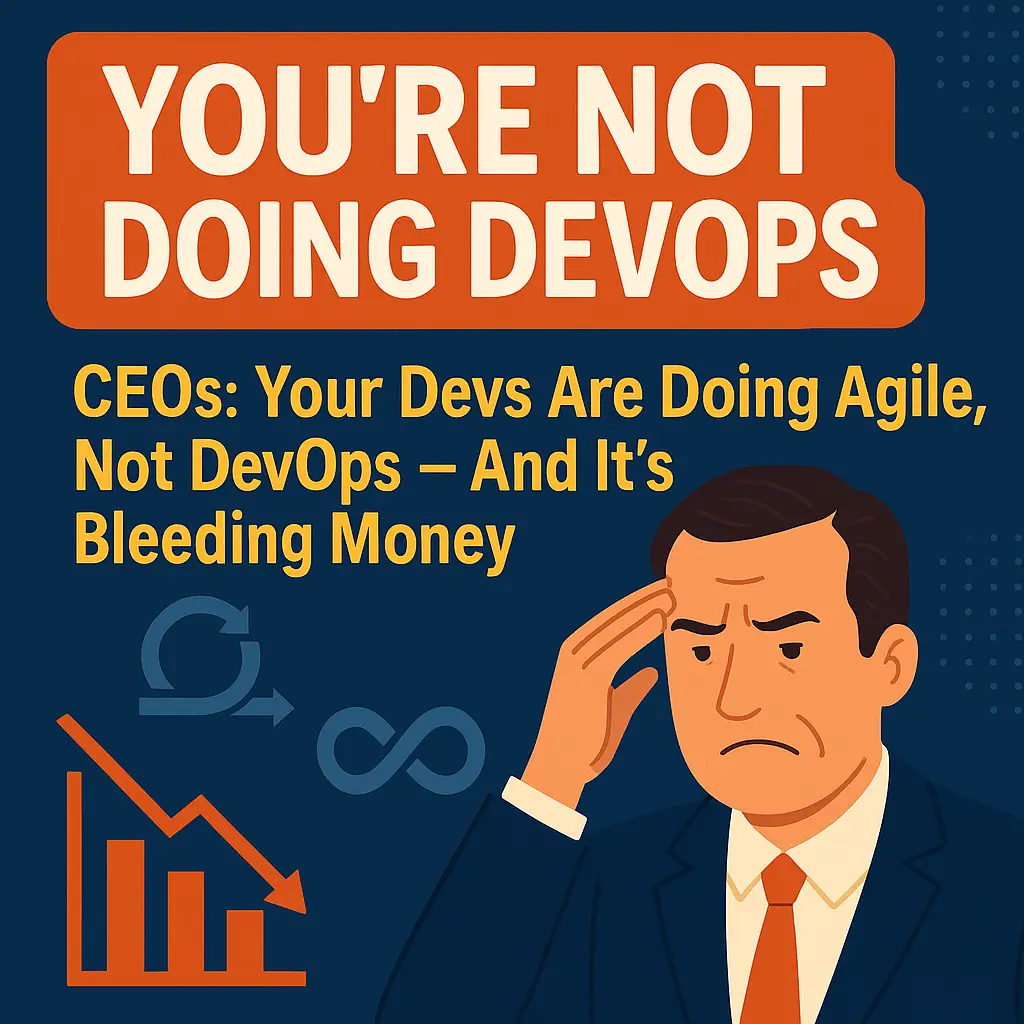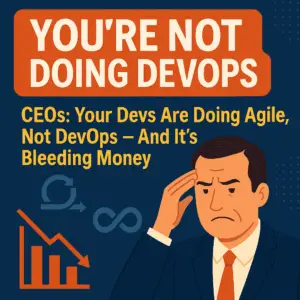Executive Summary
Many tech leaders assume they’re doing DevOps because their teams follow Agile rituals and maintain a CI/CD pipeline. But here’s the truth: you’re not doing DevOps — not really.Most companies are stuck in Agile 1.0—with DevOps nowhere in sight. This oversight quietly erodes uptime, inflates cloud spend, slows feature velocity, and makes on-call a nightmare.
This post will clarify the DevOps vs. Agile disconnect, spotlight what true DevOps transformation looks like, and show how bridging the gap leads to measurable business wins.
Introduction
You’re not doing DevOps — you’re doing Agile with a bit of automation and calling it transformation. Walk into any engineering stand-up today and you’ll hear the familiar cadence: sprints, retros, story points, demos. Agile is everywhere. But here’s the problem: Agile is about how we write software. DevOps is about how we run it.
When companies conflate the two, they end up with beautiful sprint boards but broken release pipelines, overworked ops teams, and tech debt that multiplies like rabbits.
💬 If you’re the CEO, think of this as running a smooth R&D process while the factory floor is on fire.
This post will help you recognize the signs that you’re not doing DevOps — and how to fix it.
Business Problem: Agile Without DevOps Is Half the Equation

Agile focuses on delivering incremental value. DevOps ensures that value is stable, scalable, and quick to recover. Without DevOps:
- Releases get stuck in staging.
- Incidents take hours to resolve.
- Environments drift.
- Devs throw code “over the wall” to ops.
All of this leads to:
- Higher downtime costs (each hour of downtime can cost $100k+ for mid-sized SaaS firms).
- Slower time-to-market due to friction in testing, deployment, and rollback.
- Ballooning cloud bills from inefficient environments and lack of observability.
💡 Think of DevOps as installing sensors and auto-pilots in your delivery pipeline. Without it, your pilots (devs) are flying blind.
📚 Recommended reading: Gartner on DevOps Transformation and AWS DevOps Overview
Technical Insight: You’re Not Doing DevOps Until You Transform Delivery
DevOps transformation isn’t just about tooling. It’s a cultural and architectural shift. Here’s what it involves:
1. Unified Teams and End-to-End Ownership
- Break silos: Create cross-functional squads that own services end-to-end.
- Empower devs to manage operations: monitoring, deployments, rollback.
2. Platform Engineering and Developer Enablement
- Build golden paths: Templates and automation to abstract infra pain.
- Self-service environments: Reduce ticket ops for test and deploy workflows.
3. Full-Stack Observability and Accountability
- Metrics, logs, traces wired into every deploy.
- Alerting tied to SLOs, not just uptime.
4. CI/CD Done Right with DevOps Practices
- Canary deploys, feature flags, and automated rollbacks.
- Security and compliance embedded into the pipeline.
🔍 Think of platform engineering like building the express lane on a highway. It’s how your teams ship faster and safer.
📚 Explore CNCF DevOps Landscape to understand the ecosystem of tools that support DevOps transformation.
Strategic Recommendations to Start Doing DevOps Right
If you suspect your org is Agile-only and not truly DevOps-enabled, here’s where to start:
1. Audit Your Delivery Pipeline for DevOps Maturity
- How long from code complete to production?
- Who owns incident resolution?
- What’s your MTTR (mean time to recovery)?
2. Invest in Platform Teams with DevOps Mandate
- Not another ops team—this is an enablement layer.
- Tasked with building reusable infrastructure components and tooling.
3. Redefine KPIs to Reflect DevOps Outcomes
- Measure flow (lead time, deployment frequency) and resilience (change fail rate, MTTR).
- Tie engineering metrics to business outcomes.
4. Drive Executive Sponsorship for DevOps Transformation
- DevOps transformation stalls without leadership support.
- Make it part of your quarterly OKRs.
📚 See how Thoughtworks promotes DevOps success via organizational change.
ROI: What Happens When You Actually Do DevOps
Companies that invest in DevOps maturity consistently report:
- Faster deploys (daily instead of weekly)
- Fewer outages (and faster recovery when they do happen)
- Lower cloud spend (by killing waste and drift)
- Higher developer happiness (less pager fatigue, more ownership)
See the 2023 DORA State of DevOps Report for benchmarks.
📚 For an internal link, see our post: 5 DevOps Metrics That Actually Matter
Conclusion: You’re Not Doing DevOps Until You Align Culture, Process, and Tooling
Agile without DevOps is a shiny car with no engine. If your teams are sprinting but not shipping reliably, it’s time to revisit the foundations.
Let’s talk about how your DevOps practices align with business outcomes.

